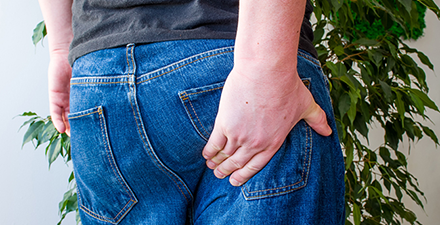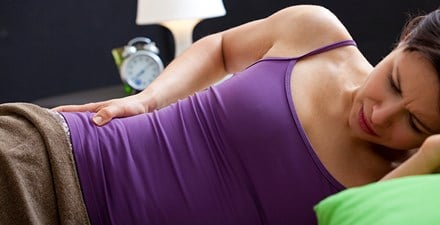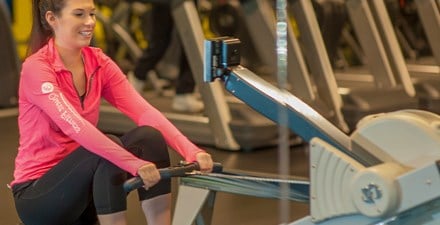Physical Therapy Guide to Lumbar Radiculopathy (Sciatica)
Lumbar radiculopathy (also known as sciatica or radiculitis) is a condition that occurs when a nerve in your low back is injured, pinched, or compressed, causing pain or other symptoms that can extend from the low back to the hip, leg, or foot. Lumbar radiculopathy can be caused by sudden trauma or by long-term stress affecting structures in the back. It most often affects people aged 30 to 50 years. Risk factors for lumbar radiculopathy include repeated lifting, participating in weight-bearing sports, obesity, smoking, sedentary lifestyles, and poor posture. The majority of lumbar radiculopathy and sciatica cases recover without surgery, and respond well to physical therapy. Physical therapists design individualized treatment programs to help people with lumbar radiculopathy reduce their pain, regain normal movement, and get back to their normal activities.
Physical therapists are movement experts. They improve quality of life through hands-on care, patient education, and prescribed movement. You can contact a physical therapist directly for an evaluation. To find a physical therapist in your area, visit Find a PT.
What Is Lumbar Radiculopathy (Sciatica)?
The spine is made up of 33 vertebrae (bones) stacked on top of each other. On the side of each vertebra are openings in the bone through which nerve roots and nerves exit the spinal canal and travel out to the hips, legs, and feet. Between each vertebra is a piece of cartilage called an "intervertebral disc" that acts like a cushion between the vertebrae.
Injuries close to the spine can cause pressure or injury to the nerves and nerve roots. These injuries may include:
- Bulging intervertebral discs ("herniated disk")
- Overstretching of a nerve or nerve root
- Tight piriformis muscle
Conditions that can cause lumbar radiculopathy to develop over time include:
- Bone spurs
- Arthritis
- Inflammation
Sudden injury can occur with a fall, when a person lifts an object awkwardly, or through trauma such as a car accident. Structures surrounding the spine, such as ligaments or nerves, can also be injured.
A slow onset of lumbar radiculopathy can occur from sitting or standing with poor posture (slumped forward) for weeks, months, or years. Poor posture can slowly overstretch ligaments in the back, allowing pressure to occur on a spinal nerve. As that pressure increases, the pain can travel farther out along the path of the nerve, causing discomfort in the hip, leg, or foot.
How Does It Feel?
Lumbar radiculopathy can cause pain, muscle tightness and weakness, or other symptoms. The pain usually starts in the low back, and can travel to the hip, leg, or foot. The location of the pain can vary depending on which nerve in the back is affected and how much it is irritated. Greater irritation causes the pain to spread farther. Spreading pain usually affects 1 leg, but may affect both legs. Pain and other symptoms can be constant or come and go, and can vary in intensity.
If a nerve or nerve root is severely pinched or compressed it can cause severe pain, muscle weakness, or extreme movement problems. Surgery may be recommended in more severe cases. On rare occasions, nerve compression can cause bladder control or bowel function problems, in which case immediate surgery is recommended.
Your physical therapist can help determine the details of your condition and whether consultation with a surgeon is necessary. Your physical therapist will work with your physician or surgeon to determine your best treatment.
Signs and Symptoms
Lumbar radiculopathy can cause a variety of symptoms. The type and location of your symptoms will depend on the amount of pressure being placed on the affected nerve(s). Symptoms may include:
- Pain and/or pressure in the back, hip, leg(s), foot/feet
- Pain that can be throbbing, aching, shooting, sharp, dull, or burning
- Inability to bend or rotate the back
- Numbness or tingling in the back, hip(s), leg(s), or feet
- Weakness in the leg(s)
- Increased pain when coughing, sneezing, reaching, or sitting
- Inability to stand up straight; being "stuck" in a position such as stooped forward
- Difficulty getting up from a chair
- Inability to remain in 1 position for a long period of time, such as sitting or standing, due to pain
- Pain that is worse in the morning
- Limping when walking
The pain or other symptoms can occur in 1 limb or both. They can be in different locations at different times, and can change depending on your activity or body positioning. For example, pain can lessen or worsen when walking versus sitting, or lying down versus standing up.
How Is It Diagnosed?
Your physical therapist will conduct a thorough evaluation that includes taking your health history. Your physical therapist also will ask you detailed questions about your injury, such as:
- Do you have loss of control of your bladder or bowel? CAUTION: Contact a medical professional immediately if you experience this condition.
- How and when did the pain start?
- At what time of day is it worse?
- What type of discomfort do you feel, and where do you feel it?
- What are you unable to do right now in your daily life due to the pain?
Your physical therapist will perform tests on your body to identify problems, such as:
- Difficulty moving
- Muscle weakness or tightness
- Changes in skin sensation (numbness)
- Changes in reflexes
- Joint stiffness
- Changes in posture
- Difficulty walking or balancing
If your physical therapist finds any of the above problems, physical therapy treatment may begin right away, to help get you on the road to recovery and back to your normal activities.
If testing indicates any concerns, your physical therapist will consult your physician or surgeon regarding the need for special diagnostic testing, such as magnetic resonance imaging (MRI). Physical therapists work closely with physicians and other health care providers to ensure you receive an accurate diagnosis, treatment, and the care you need.
How Can a Physical Therapist Help?
In all but the most extreme cases of lumbar radiculopathy, conservative care (such as physical therapy) often results in better and faster results than surgery or pain medication (such as opioid medication).
Your physical therapist will work with you to design a specific treatment program that will speed your recovery, including exercises and treatments that you can do at home. Physical therapy will help you return to your normal lifestyle and activities. The time it takes to heal the condition varies, but improvement may be achieved in 4 to 8 weeks, when a proper posture, pain reduction, stretching, and strengthening program is implemented.
During the first 24 to 48 hours following your diagnosis of lumbar radiculopathy, your physical therapist may advise you to:
- Protect the area by avoiding activity that causes worsening symptoms, such as heavy lifting.
- Avoid too much bed rest.
- Stay active around the house, and go on short walks several times per day. Movement will decrease your pain and stiffness, and help you feel better.
- Apply ice packs to the affected area for 15 to 20 minutes every 2 hours.
- Sit in firm chairs. Soft couches and easy chairs may make your problems worse.
- Consult with a physician for further services, such as medication or diagnostic tests.
Some exercises are better for individuals with lumbar radiculopathy. Your physical therapist will educate you about them. For example:
- Water exercises can be a great way to stay physically active when other forms of exercise are painful.
- Exercises prescribed for you because your physical therapist found that they reduce your leg pain are important for you to do.
- Exercises that involve lots of twisting and bending may or may not benefit you. Your physical therapist will design an individualized exercise program to meet your specific needs.
- Weight-training exercises, though very important, need to be done with proper form to avoid stress to the back.
Your physical therapist will work with you to:
Reduce pain and other symptoms. Your physical therapist will help you understand how to avoid or modify the activities that caused the injury, so healing can begin. Your therapist may use different types of treatments and technologies to control and reduce your pain and symptoms. Your treatment, based on your condition, may include specific motion exercises, mechanical traction, the application of cold or heat packs, and gentle electrotherapy such as transcutaneous electrical nerve stimulation (TENS).
Improve motion. Your physical therapist will choose specific activities and treatments to help restore normal movement in any stiff joints. These might begin with "passive" motions that the physical therapist performs for you to move your spine, and progress to active exercises and stretches that you do yourself. You can perform these motions at home and in your workplace to help hasten healing and pain relief.
Improve flexibility. Your physical therapist will determine if any of the involved muscles are tight, start helping you to stretch them, and teach you how to stretch them at home.
Improve strength. If your physical therapist finds any weak or injured muscles, the therapist will teach you the correct exercises to steadily restore your strength and agility. “Core strengthening” exercises are commonly used to restore the strength and coordination of muscles around your back, hips, abdomen, and pelvis.
Improve endurance. Restoring muscular endurance is important after an injury. Your physical therapist will develop a program of activities to help you regain the endurance you had before the injury, and improve it.
Improve posture. Your physical therapist will teach you how to improve your posture so that pressure is reduced in the injured area, and healing can begin and progress as rapidly as possible.
Learn a home program. Your physical therapist will teach you strengthening, stretching, and pain reduction exercises to perform at home. These exercises will be specific for your needs; if you do them as prescribed by your physical therapist, you can speed your recovery.
Return to activities. Your physical therapist will discuss your activity levels with you and use them to set your work, sport, and home-life recovery goals. Your treatment program will help you reach your goals in the safest, fastest, and most effective way possible. For spine and leg pain from lumbar radiculopathy, your physical therapist may teach you correct ways to lift objects (called “body mechanics”) that will help protect your spine from aggravating symptoms.
Once your pain is under control or gone, it will be important for you to continue your new posture and movement habits to keep your back healthy and pain free.
Following Surgery
In some cases, surgery is necessary to prevent further damage. If you undergo surgery for your lumbar radiculopathy, your physical therapist will work closely with you and your surgeon to help you regain motion and strength more quickly than you could on your own, and help you get back to your normal lifestyle as quickly as possible.
Can This Injury or Condition Be Prevented?
Lumbar radiculopathy may be preventable. To reduce the likelihood of developing this condition:
- Practice good posture when sitting and standing, including when driving a car.
- Use proper body mechanics when lifting, pushing, pulling, or performing any action that puts extra stress on your spine.
- Maintain a healthy weight. This will reduce the stress on your spine.
- Stop smoking.
- Discuss your occupation with a physical therapist, who can provide an analysis of your job tasks and offer suggestions for reducing your risk of injury.
- Keep your muscles strong and flexible. Participate in a consistent program of physical activity to maintain a healthy fitness level.
To help prevent recurrence of lumbar radiculopathy, follow the above advice, and:
- Continue the new posture and movement habits that you learned from your physical therapist to keep your back healthy.
- Continue to do the home-exercise program your physical therapist taught you to help maintain your improvements.
- Continue to be physically active and stay fit.
What Kind of Physical Therapist Do I Need?
All physical therapists are prepared through education and experience to treat people who have low back and leg pain as a result of lumbar radiculopathy. You may want to consider:
- A physical therapist who is experienced in treating people with orthopedic, or musculoskeletal, problems.
- A physical therapist who is a board-certified clinical specialist or who completed a residency or fellowship in orthopaedic physical therapy. This therapist has advanced knowledge, experience, and skills that may apply to your condition.
You can find physical therapists who have these and other credentials by using Find a PT, the online tool built by the American Physical Therapy Association to help you search for physical therapists with specific clinical expertise in your geographic area.
General tips when you’re looking for a physical therapist:
- Get recommendations from family and friends or from other health care providers.
- When you contact a physical therapy clinic for an appointment, ask about the physical therapists’ experience in helping people with a herniated disc.
- Be prepared to describe your symptoms in as much detail as possible, and say what makes your symptoms worse.
The American Physical Therapy Association believes that consumers should have access to information that could help them make health care decisions and also prepare them for their visit with their health care provider.
The following articles provide some of the best scientific evidence related to physical therapy treatment of a lumbar radiculopathy. The articles report recent research and give an overview of the standards of practice for treatment both in the United States and internationally. The article titles are listed by year and linked either to a PubMed abstract of the article or to free full text, so that you can read it or print out a copy to bring with you to your health care provider.
Apeldoorn AT, van Helvoirt H, Meihuizen H, et al. The influence of centralization and directional preference on spinal control in patients with nonspecific low back pain. J Orthop Sports Phys Ther. 2016;46(4):258–269. Article Summary in PubMed.
Thackeray A, Fritz JM, Childs JD, Brennan GP. The effectiveness of mechanical traction among subgroups of patients with low back pain and leg pain: a randomized trial. J Orthop Sports Phys Ther. 2016;46(3):144–154. Free Article.
North American Spine Society Evidence-Based Clinical Guidelines Committee. Clinical Guidelines for Diagnosis and Treatment of Lumbar Disc Herniation With Radiculopathy. Burr Ridge, IL: North American Spine Society; 2012:29–30.
Albert HB, Hauge E, Manniche C. Centralization in patients with sciatica: are pain responses to repeated movement and positioning associated with outcome or types of disc lesions? Eur Spine J. 2012;21(4):630–636. Article Summary in PubMed.
Kennedy DJ, Noh MY. The role of core stabilization in lumbosacral radiculopathy. Phys Med Rehabil Clin N Am. 2011;22(1):91–103. Article Summary in PubMed.
*PubMed is a free online resource developed by the National Center for Biotechnology Information (NCBI). PubMed contains millions of citations to biomedical literature, including citations in the National Library of Medicine’s MEDLINE database.
Expert Review:
Nov 20, 2017
Revised:
Nov 20, 2017
Content Type: Guide
Lumbar Radiculopathy and Sciatica
PT, DPT
The editorial board
You Might Also Like...
Podcast
Benefits of Early Physical Therapy Treatment for SciaticaNov 5, 2020
Is a wait-and-see approach to sciatica (back pain that radiates to the leg) needlessly prolonging pain? Physical therapist Julie Fritz answers that question
Podcast
Sciatica and Physical TherapyNov 8, 2018
As many as 40% of people will get sciatica during their lifetime, according to Harvard Medical School, and the condition becomes more frequent with
Patient Stories
Physical Therapy Helps Teenager Return to School and LifeJul 31, 2018
"Physical therapy was the thing that helped me the most."


